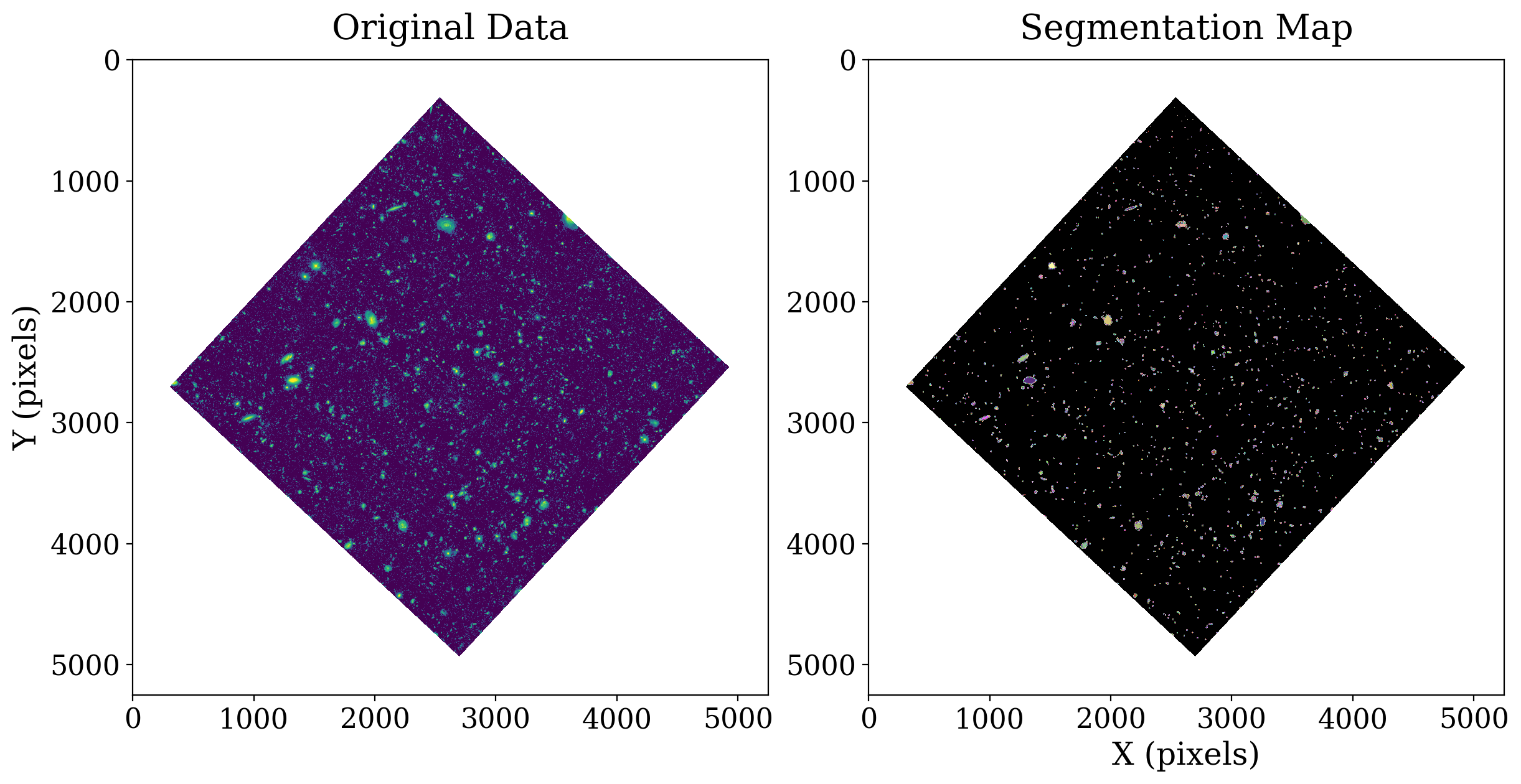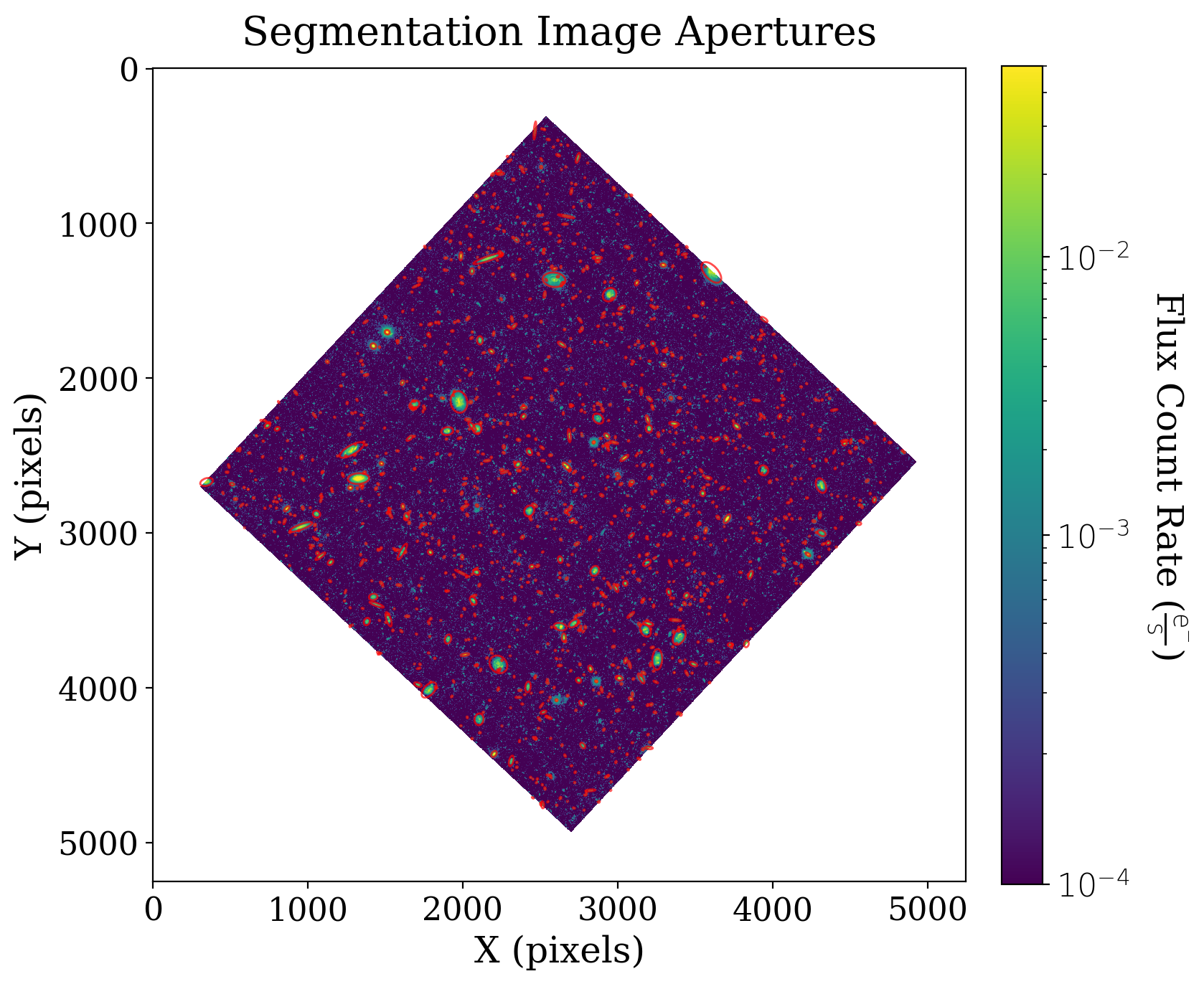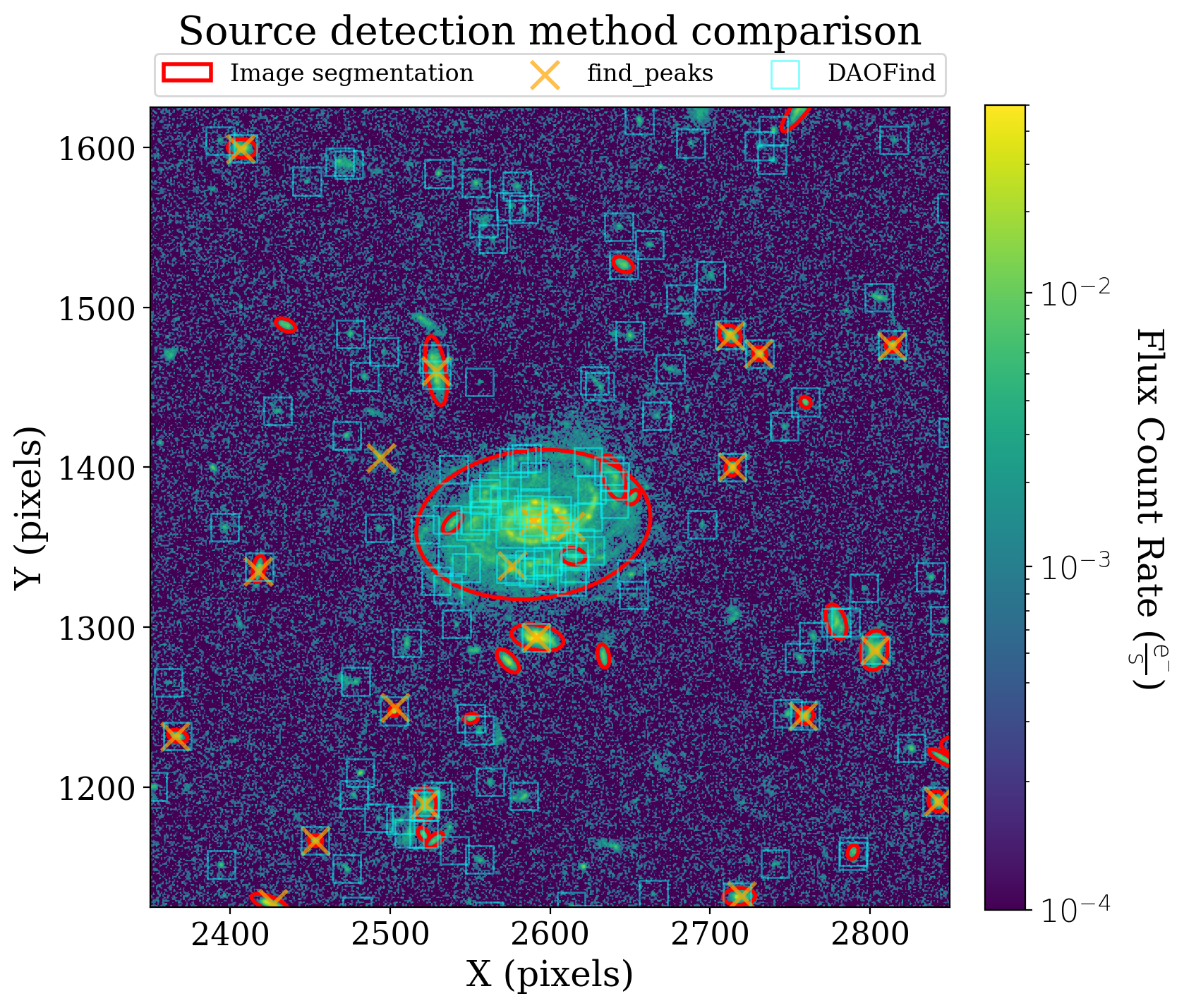8.4.2. Application to the XDF#
8.4.2.1. Data for this notebook#
We will be manipulating Hubble eXtreme Deep Field (XDF) data, which was collected using the Advanced Camera for Surveys (ACS) on Hubble between 2002 and 2012. The image we use here is the result of 1.8 million seconds (500 hours!) of exposure time, and includes some of the faintest and most distant galaxies that had ever been observed.
The methods demonstrated here are also available in the photutils.detection documentation.
The original authors of this notebook were Lauren Chambers, Erik Tollerud and Tom Wilson.
import warnings
from astropy.convolution import convolve
from astropy.nddata import CCDData
from astropy.stats import sigma_clipped_stats, SigmaClip
import astropy.units as u
from astropy.visualization import ImageNormalize, LogStretch
import matplotlib.pyplot as plt
from matplotlib.ticker import LogLocator
import numpy as np
from photutils.aperture import EllipticalAperture
from photutils.background import Background2D, MeanBackground
from photutils.centroids import centroid_2dg
from photutils.detection import find_peaks, DAOStarFinder, IRAFStarFinder
from photutils.segmentation import detect_sources, make_2dgaussian_kernel, SourceCatalog
from photutils.utils import make_random_cmap
# Show plots in the notebook
%matplotlib inline
xdf_image = CCDData.read('hlsp_xdf_hst_acswfc-60mas_hudf_f435w_v1_sci.fits')
# Define the mask
mask = xdf_image.data == 0
xdf_image.mask = mask
mean, median, std = sigma_clipped_stats(xdf_image.data, sigma=3.0, maxiters=5, mask=xdf_image.mask)
plt.style.use('../photutils_notebook_style.mplstyle')
Beyond traditional source detection methods, an additional option for identifying sources in image data is a process called image segmentation. This method identifies and labels contiguous (connected) objects within an image.
You might have noticed that, in the previous source detection algorithms, large and extended sources are often incorrectly identified as more than one source. Segmentation would label all the pixels within a large galaxy as belonging to the same object, and would allow the user to then measure the photometry, centroid, and morphology of the entire object at once.
8.4.2.2. Creating a SegmentationImage#
In photutils, image segmentation maps are created using the threshold method in the detect_sources function. This method identifies all of the objects in the data that have signals above a determined threshold (usually defined as a multiple of the standard deviation) and that have more than a defined number of adjoining pixels, npixels. The data can also optionally be smoothed using a kernel, filter_kernel, before applying the threshold cut.
The detect_sources function returns a SegmentationImage object: an array in which each object is labeled with an integer. As a simple example, a segmentation map containing two distinct sources might look like this:
0 0 0 0 0 0 0 0 0 0
0 1 1 0 0 0 0 0 0 0
1 1 1 1 1 0 0 0 2 0
1 1 1 1 0 0 0 2 2 2
1 1 1 0 0 0 2 2 2 2
1 1 1 1 0 0 0 2 2 0
1 1 0 0 0 0 2 2 0 0
0 1 0 0 0 0 2 0 0 0
0 0 0 0 0 0 0 0 0 0
where all of the pixels labeled 1 belong to the first source, all those labeled 2 belong to the second, and all null pixels are designated to be background.
Let’s see make the segmentation image for the XDF see what that segmentation map looks like.
# Define threshold and minimum object size
threshold = 5. * std
npixels = 10
fwhm = 5
kernel_size = 5
kernel = make_2dgaussian_kernel(fwhm, size=kernel_size)
convolved_data = convolve(xdf_image.data, kernel)
# Create a segmentation image
segm = detect_sources(convolved_data, threshold, npixels)
print('Found {} sources'.format(segm.max_label))
Found 1325 sources
The number of sources found with this method is similar to that found with the other methods we have considered. A more detailed comparison is made later in this section.
# Set up the figure with subplots
fig, [ax1, ax2] = plt.subplots(1, 2, figsize=(12, 6))
plt.tight_layout()
# Plot the data
# Set up the normalization and colormap
norm_image = ImageNormalize(vmin=1e-4, vmax=5e-2, stretch=LogStretch(), clip=False)
cmap = plt.get_cmap('viridis')
cmap.set_bad('white') # Show masked data as white
# Plot the original data
fitsplot = ax1.imshow(np.ma.masked_where(xdf_image.mask, xdf_image),
norm=norm_image, cmap=cmap)
ax1.set_ylabel('Y (pixels)')
ax1.set_title('Original Data')
# Plot the segmentation image
segplot = ax2.imshow(np.ma.masked_where(xdf_image.mask, segm), vmin=1, cmap=segm.cmap)
ax2.set_xlabel('X (pixels)')
ax2.set_title('Segmentation Map')
# # Define the colorbar
# cbar_ax = fig.add_axes([1, 0.09, 0.03, 0.87])
# cbar = plt.colorbar(segplot, cbar_ax)
# cbar.set_label('Object Label', rotation=270, labelpad=30)
Text(0.5, 1.0, 'Segmentation Map')

Compare the sources in original data to those in the segmentation image. Each color in the segmentation map denotes a separate source.
You can easily see that larger galaxies are shown in the segmentation map as contiguous objects of the same color - for example, the two yellow and pink galaxies near (1200, 2500). Each pixel containing light from the same galaxy has been labeled as belonging to the same object.
8.4.2.3. Analyzing source_properties#
Once we have a SegmentationImage object, photutils provides many powerful tools to manipulate and analyze the identified objects.
Individual objects within the segmentation map can be altered using methods such as relabel to change the labels of objects, remove_labels to remove objects, or deblend_sources to separating overlapping sources that were incorrectly labeled as one source.
However, perhaps the most powerful aspect of the SegmentationImage is the ability to create a catalog using SourceCatalog to measure the centroids, photometry, and morphology of the detected objects:
catalog = SourceCatalog(xdf_image.data, segm)
table = catalog.to_table()
print(table)
print(table.colnames)
label xcentroid ycentroid ... kron_flux kron_fluxerr
...
----- ------------------ ------------------ ... ------------------- ------------
1 2465.7386366359437 400.20823876076145 ... 3.786962750366322 nan
2 2509.6568703244993 389.49620068710044 ... 0.16299322050344217 nan
3 2525.699589429596 393.73426523584817 ... 1.236078180507074 nan
4 2552.324164878554 458.6506964037056 ... 0.53740330791435 nan
5 2613.722439123769 463.56403761707145 ... 0.23589840050346006 nan
6 2634.6926896288364 492.74771005940875 ... 0.4048265965503719 nan
7 2678.0402364491715 496.13420772248094 ... 0.23127518888263288 nan
8 2585.5976310775773 507.32125399722963 ... 0.3348800151373088 nan
9 2325.5275032287905 553.6827394979126 ... 0.17353760980104416 nan
... ... ... ... ... ...
1316 2452.133550261183 4710.038077384896 ... 0.35094793112418704 nan
1317 2630.7479686391625 4712.105110099765 ... 0.5244500489085997 nan
1318 2676.29647008758 4732.968757310911 ... 0.11435139689102855 nan
1319 2878.4136666933023 4736.32279556149 ... 0.6443531394233689 nan
1320 2549.8004897409874 4735.490047108536 ... 0.1739662639656022 nan
1321 2505.04369005797 4750.25154033696 ... 1.175406402745871 nan
1322 2515.5577522110757 4755.66229816978 ... 1.299899376790302 nan
1323 2606.917351752249 4758.01416049386 ... 0.22313752225793876 nan
1324 2717.996758340226 4776.535815969104 ... 0.25433285433797137 nan
1325 2783.4952592029003 4789.55106336388 ... 0.1603409271870089 nan
Length = 1325 rows
['label', 'xcentroid', 'ycentroid', 'sky_centroid', 'bbox_xmin', 'bbox_xmax', 'bbox_ymin', 'bbox_ymax', 'area', 'semimajor_sigma', 'semiminor_sigma', 'orientation', 'eccentricity', 'min_value', 'max_value', 'local_background', 'segment_flux', 'segment_fluxerr', 'kron_flux', 'kron_fluxerr']
8.4.2.3.1. Creating apertures from segmentation data#
We can use this information to create isophotal ellipses for each identified source. These ellipses can also later be used as photometric apertures.
# Define the approximate isophotal extent
r = 4. # pixels
# Create the apertures
apertures = []
for obj in catalog:
position = (obj.xcentroid, obj.ycentroid)
a = obj.semimajor_sigma.value * r
b = obj.semiminor_sigma.value * r
theta = obj.orientation
apertures.append(EllipticalAperture(position, a, b, theta=theta))
# Set up the figure with subplots
fig, ax1 = plt.subplots(1, 1, figsize=(8, 8))
# Plot the data
fitsplot = ax1.imshow(np.ma.masked_where(xdf_image.mask, xdf_image),
norm=norm_image, cmap=cmap)
# Plot the apertures
for aperture in apertures:
aperture.plot(color='red', lw=1, alpha=0.7, axes=ax1)
# Define the colorbar
cbar = plt.colorbar(fitsplot, fraction=0.046, pad=0.04, ticks=LogLocator())
def format_colorbar(bar):
# Add minor tickmarks
bar.ax.yaxis.set_minor_locator(LogLocator(subs=range(1, 10)))
# Force the labels to be displayed as powers of ten and only at exact powers of ten
bar.ax.set_yticks([1e-4, 1e-3, 1e-2])
labels = [f'$10^{{{pow:.0f}}}$' for pow in np.log10(bar.ax.get_yticks())]
bar.ax.set_yticklabels(labels)
format_colorbar(cbar)
# Define labels
cbar.set_label(r'Flux Count Rate ({})'.format(xdf_image.unit.to_string('latex')),
rotation=270, labelpad=30)
ax1.set_xlabel('X (pixels)')
ax1.set_ylabel('Y (pixels)')
ax1.set_title('Segmentation Image Apertures');

8.4.2.4. Comparison with other detection methods#
We begin by finding sources using DAOStarFinder and find_peaks.
with warnings.catch_warnings(action="ignore"):
sources_findpeaks = find_peaks(xdf_image.data - median, mask=xdf_image.mask,
threshold=20. * std, box_size=29,
centroid_func=centroid_2dg)
# Add an ID column to the find_peaks result
sources_findpeaks["source_id"] = np.arange(len(sources_findpeaks))
daofind = DAOStarFinder(fwhm=fwhm, threshold=threshold)
sources_dao = daofind(np.ma.masked_where(xdf_image.mask, xdf_image))
A plot of a random subset of sources highlights the differences between the methods.
fig = plt.figure(figsize=(8, 2.5))
sub_figs = fig.subfigures(nrows=2, ncols=4, wspace=0.01, hspace=0.01)
cutout_size = 60
rng = np.random.default_rng(seed=8675309)
srcs = rng.permutation(sources_findpeaks)[:len(sub_figs.flatten())]
for a_fig, src in zip(sub_figs.flatten(), srcs):
sub_axs = a_fig.subplot_mosaic([["orig", "segm"]], sharex=True, sharey=True, )
left = int(src['x_peak'] - cutout_size)
bottom = int(src['y_peak'] - cutout_size)
right = left + 2 * cutout_size
top = bottom + 2 * cutout_size
slc = (slice(bottom, top), slice(left, right))
sources_in_cutout_fp = ((left < sources_findpeaks["x_centroid"]) & (sources_findpeaks["x_centroid"] < right) &
(bottom < sources_findpeaks["y_centroid"]) & (sources_findpeaks["y_centroid"] < top))
sources_in_cutout_dao = ((left < sources_dao["xcentroid"]) & (sources_dao["xcentroid"] < right) &
(bottom < sources_dao["ycentroid"]) & (sources_dao["ycentroid"] < top))
sub_axs["orig"].imshow(xdf_image.data[slc], cmap=cmap, norm=norm_image, origin="lower")
sub_axs["orig"].scatter(sources_findpeaks["x_centroid"][sources_in_cutout_fp] - left,
sources_findpeaks["y_centroid"][sources_in_cutout_fp] - bottom,
marker="x", color="orange", s=100, label="Find peaks")
sub_axs["orig"].scatter(sources_dao["xcentroid"][sources_in_cutout_dao] - left,
sources_dao["ycentroid"][sources_in_cutout_dao] - bottom,
marker="s", facecolor="none", edgecolor="cyan", s=200,
alpha=0.5, label="DAOFind")
rand_cmap = make_random_cmap()
rand_cmap.set_under('black')
sub_axs["segm"].imshow(segm.data[slc], cmap=rand_cmap, vmin=1, vmax=len(sources_findpeaks), origin="lower")
src_id = src["source_id"]
# ax.text(2, 2, str(src_id), color='w', va='top')
a_fig.suptitle(f"Source {src_id}", fontsize=10)
for ax in sub_axs.values():
ax.set_xticks([])
ax.set_yticks([])
fig.suptitle("'Source detection method comparison", y=1.1)
a_fig.legend(ncols=2, bbox_to_anchor=(-.2, 0.2));

Star finding finds almost all of the point-like sources in these cutouts, but also identifies many sources in each extended object. Peak finding misses many of the star-like objects and sometimes assigns multiple objects to a single extended source. Image segmentation identifies extended sources as single objects but misses most of the small star-like objects. Adjusting the image segmentation parameters to allow smaller sources would improve detection of those objects.
We now look at the large galaxy near the top center of the XDF. Image segmentation is the only method that correctly identifies that large galaxy as a single object.
# Set up the figure with subplots
fig, ax1 = plt.subplots(1, 1, figsize=(8, 8))
# Plot the data
fitsplot = ax1.imshow(np.ma.masked_where(xdf_image.mask, xdf_image),
norm=norm_image, cmap=cmap)
# Plot the apertures
apertures[0].plot(color='red', lw=2, alpha=1, axes=ax1, label="Image segmentation")
for aperture in apertures[1:]:
aperture.plot(color='red', lw=2, alpha=1, axes=ax1)
# Add find_peaks sources
ax1.scatter(sources_findpeaks["x_centroid"], sources_findpeaks["y_centroid"],
marker="x", color="orange", s=200, lw=2, alpha=0.7, label="find_peaks")
# Add DAOStarFinder sources
ax1.scatter(sources_dao["xcentroid"], sources_dao["ycentroid"],
marker="s", facecolor="none", edgecolor="cyan", s=200, alpha=0.5, label="DAOFind")
# Define the colorbar
cbar = plt.colorbar(fitsplot, fraction=0.046, pad=0.04, ticks=LogLocator())
format_colorbar(cbar)
# Define labels
cbar.set_label(r'Flux Count Rate ({})'.format(xdf_image.unit.to_string('latex')),
rotation=270, labelpad=30)
ax1.set_xlabel('X (pixels)')
ax1.set_ylabel('Y (pixels)')
top = 1125
left = 2350
cutout_size = 500
ax1.set_xlim(left, left + cutout_size)
ax1.set_ylim(top, top + cutout_size)
ax1.legend(ncols=3, loc='lower center', bbox_to_anchor=(0.5, 1))
ax1.set_title('Source detection method comparison', y=1.05);

8.4.2.5. Summary#
The image above nicely captures the differences between the source detection methods we have discussed. DAOStarFinder does an excellent job detecting the star-like sources in the image but not the more extended sources. find_peaks detects both extended and point-like sources, but misses several sources. Image segmentation does an excellent job detecting sources, and could detect the smaller sources in this image if we reduced the minimum number of pixels in each source.

